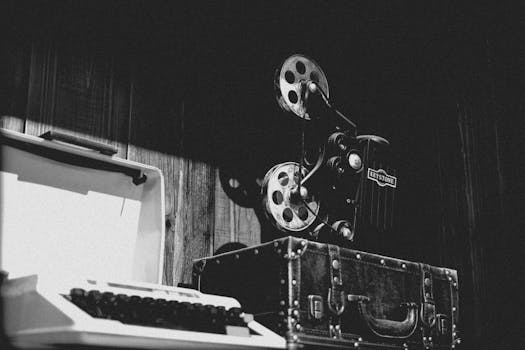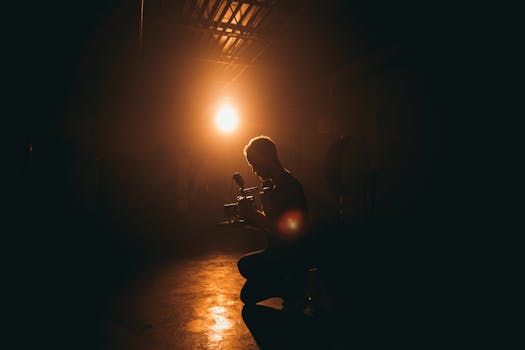TV Shows
The Importance of Music in Setting a Show’s Tone: Why TV Music Shapes Every Scene
TV music transforms scenes, guides emotions, and shapes memorable moments in your favorite shows. Learn how the right soundtrack defines tone, builds character, and makes each series unforgettable.
Advertisement
You might remember a scene from your favorite series where music sent chills down your spine. Without realizing it, tv music becomes the invisible hand changing how the best moments in tv shows feel.
Music guides our emotions, highlights surprise, and cues us for heartbreak or laughter. It’s what separates a powerful drama from a bland scene, creating unforgettable atmospheres in modern television.
This article reveals practical reasons tv music matters so much to the tone of tv shows and how you can spot every clever technique next time you tune in.
Spotting Emotional Shifts Using TV Music As Your Guide
Recognizing mood changes in tv shows gets easier when you pay attention to the tv music. Many scenes rely on a finely matched score to underscore subtle emotions, giving the viewer a shorthand they can actually feel.
For instance, as an argument escalates between two leads, tv music may build from gentle strings to distorted synths. This audio cue nudges viewers to anticipate signficant drama, even before dialogue spells it out.
Harmonies That Signal Mood Changes
Producers layer major keys for optimism, while minor keys bring out tension or sadness. Next time a cheerful montage rolls, notice how tv music uses bouncy harmonies and playful percussion to reinforce hope.
Conversely, if a show cuts to a dimly lit room, unsettled chords or abrupt silence often take over. This creates unease before anything is revealed. You’ll sense pressure mounting every time the score subtly shifts.
When the scene flips from happiness to conflict, a clever change in music directly signals the transformed mood. This musical strategy gives the audience an unspoken context for every character’s behavior.
Volume and Pace Change Engagement
Louder music naturally grabs your attention, signaling scenes you should focus on. Fast-paced tracks heighten adrenaline, often during chases or argument sequences, while slower tempos invite contemplation or reflection during quiet moments.
TV music acts as a metronome, keeping energy high in action-heavy tv shows or drawing you into intimate character studies. The tempo tells you whether to get excited or brace for emotion.
You can try this: mute the tv during a tense scene, then unmute. Notice how much more engaged you feel with the tv music. It’s a lesson in tv storytelling every viewer can test during their next watch.
| Music Element | Scene Example | Emotional Effect | What To Look For Next Time |
|---|---|---|---|
| Major Key | Family reunion | Warmth, hope | Listen for upbeat melodies in joyful scenes |
| Minor Key | Character separation | Tension, sadness | Spot melancholic harmonies as conflict arises |
| Silence | Revelation moment | Shock, anticipation | Notice when music drops out, heightening tension |
| Electronic Sound | Sci-fi chase | Excitement, threat | Be alert for synths in modern action sequences |
| Orchestral Swell | Hero’s triumph | Inspiration, closure | Feel the big musical build for major payoffs |
Embedding Character Identity Through TV Music
Assigning a musical theme or motif to a character helps viewers recognize their presence and predict their behavior. Every lead in a memorable tv show gains an audio footprint through specific tv music choices.
Attaching a style—like harp for innocence or distorted guitar for rebellion—expands the depth of a character. This creates recognition and emotional continuity every time that sound returns.
Motif Building For Individuality
Characters with recurring musical cues become more distinct. Think of the looming brass for a villain or gentle piano for a trusted friend. Each note prepares viewers for their next move, with no need for extra dialogue.
Assigning instruments can be like dressing a character in signature wardrobe. A western hero’s twangy guitar enters first, warning you of their iconic style and mood shift.
- Use a consistent melody for major characters so viewers anticipate their role—this deepens character presence and hints at internal change.
- Introduce variations as the character grows, showing development through new musical colors.
- Reserve certain sounds (like ominous strings) for villain reveals, priming the audience for conflict or betrayal as soon as the notes emerge.
- In intimate scenes, soften the arrangement—subtle piano or flute gives space for vulnerability without overwhelming dialogue.
- Contrast musical motifs between leads. When two characters with opposing themes interact, the clash in tv music cues up their dynamic instantly.
These choices help tv music become part of the character’s essence across episodes, much like recognizable costumes or catchphrases.
Blending Music and Dialogue
Letting music gently bleed beneath dialogue keeps the tone consistent. A low hum during a confession can emphasize sincerity, while a sharp violin snap after a secret makes the truth sting.
Mixers balance volume carefully so music never overpowers critical lines. Good tv shows use music as a subtle emotional undercurrent, not a distraction.
- Lower music volume when delivering key revelations to allow words to land powerfully.
- Let music linger on silence after a character’s bold decision, extending emotional resonance.
- Fade in music gradually as scenes shift from casual to intense.
- Match music pace to dialogue tempo to keep energy even—rapid conversation flows with brisk rhythm, while slow monologues need gentle backgrounds.
- Switch themes instantly during surprise twists to keep viewers on edge.
This blending is a guiding principle for sound designers: make the tv music a scene’s invisible partner for every conversation fans remember.
Crafting Atmosphere With Genre-Specific TV Music Styles
Match music style to the tv show’s genre, and viewers immediately sense where they are—be it a crime-ridden city, a magical kingdom, or a suburban home. Genre cues make story worlds believable.
Producers often stick to musical conventions for a reason. Viewers subconsciously recognize jazz in private detective stories or sweeping orchestras in period dramas, understanding the genre before anyone speaks.
Building World Identity With Unique Elements
Adding unexpected tv music elements creates an original sonic signature. A fantasy show might blend folk instruments with digital beats, signaling a setting where the old meets the new.
Action thrillers gain energy with relentless percussion, while sitcoms choose peppy guitars for lightness. Each distinct style lets viewers step into a new world in under a minute of screen time.
You can experiment by imagining what tv music you’d use for your favorite show—would you pick modern hip hop for an ancient tale, or a haunting lullaby for a police drama?
Analogies for Everyday Understanding
Just as certain scents trigger memories, genre-specific tv music instantly primes you for what’s ahead. Think of hearing sleigh bells before you see snow: the anticipation comes from familiar sound cues.
In horror, sharp strings act like jump-scares for your ears. Comedies, in contrast, feel like a musical hug. The key is picking sounds that tiny children or lifelong fans immediately associate with each mood.
Setting the right sonic expectation is a form of respect for the audience—fans know whether to laugh, gasp, or sit on the edge knowing what kind of story they’ve entered.
Heightening Big Moments: TV Music As Emotional Amplifier
Strong tv shows use swelling music for resolutions and sudden silence for shocks. Each choice increases emotional impact, helping scenes stick in your memory long after credits roll.
Finales that stay with you—like the ending montage of a beloved series—usually include a simple, repeating melody. Audiences associate the music with climactic visuals, forging a permanent bond tied to that story’s close.
Crescendos and Payoff
In a hero’s victory, composers build orchestral layers, reaching a loud peak. This musical crescendo mimics the rising action you see onscreen, underlining triumph more than words ever could.
Meanwhile, sudden drops to silence after loud scores create emotional whiplash, making viewers hold their breath. TV music editors use these contrasts to give weight to pivotal moments in the plot.
Directors often cue musicians with phrases like, “Let’s let the music breathe here,” encouraging scores that lift, not overpower, the narrative’s big emotional beats.
Memory Anchoring Through Repetition
Repeating a key motif at high-impact moments cements both the feeling and the story in the viewer’s mind. You start to expect certain themes when big events come, heightening anticipation and payoff.
When you watch a tv show finale, listen for echoes of that show’s earliest melodies. This small touch brings fans full circle, closing narrative arcs both emotionally and sonically.
It’s a trick you can spot: when you feel nostalgia or closure swelling alongside music, credits aren’t far behind. That’s the power of tv music in storytelling.
Using TV Music To Guide Pacing and Scene Structure
Directors work closely with composers to ensure tv music never drags or distracts. Instead, it nudges story pacing, supporting crisp transitions and highlighting every plot twist.
Each television genre assigns different pacing needs—crime stories pulse with urgency, while family dramas move with gentle patience. Smart music placement makes these rhythms work seamlessly.
Editing to Musical Tempo
Scenes playing over fast beats feel short and urgent. Quick cuts and jumpy editing paired with driving music create a sense of time slipping away or decisions needing to happen quickly.
On the other hand, lingering music and long, sustained notes support slower scenes. This is useful for exploring character reactions or backstories, encouraging viewers to reflect and connect deeply.
If you want to understand a director’s pacing choices, compare the background music’s tempo to the editing speed. The closer the match, the more pleasing the viewing experience feels.
Actionable Steps For Spotting Scene Pacing
Pause after a major scene change. Replay the moment with your eyes closed and focus just on the tv music. Does your breathing rate change? If so, the pacing worked.
Directors sometimes speed up music before cliffhangers, then let it drop for shock. This musical push-and-pull keeps audiences returning every week and talking until the next episode.
Try noting when you lose interest or get drawn in—it’s probably more about the background tv music than the script, reminding you where power really lies in every show.
Building Series-Wide Identity With Consistent TV Music
A recognizable soundtrack can become a tv show’s calling card. Think of legendary opening themes, or those signature chord progressions that instantly tell you what you’re watching—this is how tv music turns casual viewers into loyal fans.
Music supervisors select or compose themes that appear episode after episode, anchoring new storylines within a unified world. By keeping elements consistent, they create brand recognition and long-term emotional attachment.
Checklist For Creating A Series Theme
Pick one instrument family that matches your show’s core vibe—dark piano for thrillers, brass for comedies. Stick with this as the foundation for variation.
Weave in accents from the genre’s culture: for example, an urban drama adds hip hop beats, while a coastal mystery leans on surf guitar riffs. Authenticity builds believability.
Repeat the main melody at each story turn, varying tempo to match mood—from energetic openers to softer closing credits. This habit forges a sense of homecoming after each episode.
Scenario: Audience Recognition and Anticipation
A group of friends meets weekly to watch their favorite series. The opening notes make everyone hush, ready for the story. Familiar tv music triggers anticipation, making every episode an event.
Even years later, they can hum the theme together, instantly recalling in-jokes and memorable scenes. The music outlasts even the characters, forming a cultural touchstone for the whole group.
Producers aiming to create hits prioritize these unifying motifs, understanding that audience attachment starts at the very first note of tv music, not just the first line of dialogue.
Conclusion: Embracing TV Music’s Authority In Storytelling
Every aspect of tv music shapes the ways viewers experience tv shows. Signature motifs, bold crescendos, and thoughtful silences each craft unique moods, solidify character identities, and guide every episode’s rhythm and expectation.
Noticing these details makes you a more attentive fan. By tuning into background music and recognizing repeated themes, you’ll enjoy richer tv storytelling and find greater meaning even in the smallest scenes.
The next time you sit down to watch, let the tv music be your compass. It offers secret instructions for sensing drama, laughter, heartache, and triumph—proving great shows play their best notes right from the start.
Trending Topics

Movies That Defined Each Decade in Film History: An Essential Guide
Trace film history through defining movies that captured each decade’s spirit and cultural transformation.
Keep Reading
How Editing Turns Raw Footage Into Movie Magic: The Power of Film Editing
Learn how film editing transforms raw footage into seamless visual storytelling that drives rhythm, tone, and emotion.
Keep Reading

